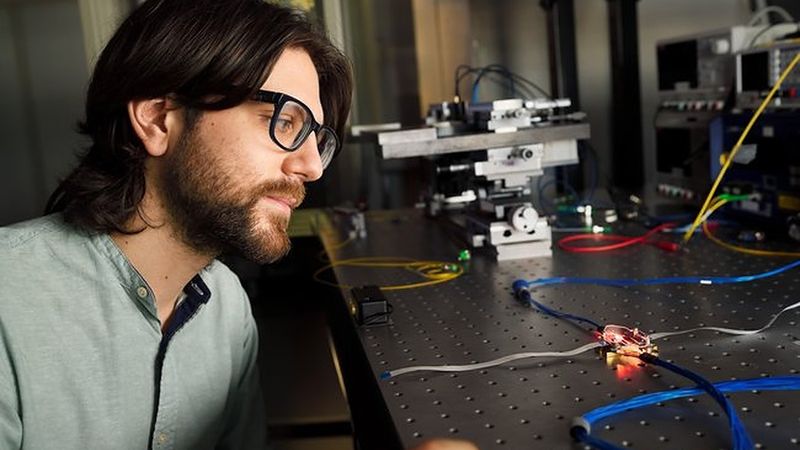Radio from laser light
Álvaro Morales Vicente will defend his thesis on December 7th at the department of Electrical Engineering of the TUe

Foto: Bart van Overbeeke
In order to keep up with the growth in - mobile - data traffic, wireless signals with an increasingly shorter wavelength are required. Doctoral candidate Álvaro Morales Vicente investigated how you can generate and transmit so-called millimeter waves with the use of photonic chips.
Those of us working from home who - out of necessity or by choice - have taken a closer look at their Wi-Fi network recently, will know that the router sends signals over two frequencies: 2.4 Gigahertz and 5 Gigahertz. The latter connection is faster, but also has a shorter range unfortunately, due to the shorter radio waves (6 centimeters instead of 12.5) - which is why an extra Wi-Fi point is sometimes needed to enhance the signal.
In order to provide everyone with ultrafast internet indoors and outdoors, to allow self-driving cars to communicate with each other, or to enable wireless data transfer within data centers, ‘data rates’ of several Gigabits per second are required. For this, even higher frequencies are needed, ranging from 30 to 300 Gigahertz, corresponding to wavelengths of a few millimeters.
Beat
This poses several challenges, doctoral candidate Álvaro Morales Vicente from Spain says. “Since short waves cover a smaller range, the signals need to be steered in a very specific direction over a short distance. That can be done with several antennas in a row.” In addition, generating such high frequencies with traditional electronics is no easy task in itself, Morales Vicente emphasizes. “The main problem is the limited bandwidth of the modulation that can be handled by traditional electronics, which means that you cannot achieve the desired high bit rates.”
There is an alternative: using laser light to very accurately generate the desired radio frequencies. Laser light has a much higher frequency than radio waves, but combining two laser beams with slightly different ‘colors’ leads to a periodic variation in light intensity caused by interference, Morales Vicente explains. “That difference frequency can be converted to a radio signal with the use of a light detector.” This phenomenon is comparable to the ‘beating’ you can hear when you pluck two strings of a slightly out of tune guitar.
Optical Chip
The next essential step is ‘aiming’ the millimeter waves to bring the signal from A to B. “That too works with interference. When the signal is transmitted by a row of antennas, each with a slightly different delay, the radio signal is steered in a certain direction.” Morales Vicente managed to realize this effect at different wavelengths in the lab by creating the signals on an optical chip.
Optical generation of millimeter waves is energy-efficient and flexible, but this technology is still in its infancy. “The major challenge is to combine all the necessary steps in a handy device. That includes generating a signal with the right frequency, modulating this to store data in it, and steering the millimeter waves in a specific direction to deliver said data.”
The idea is that all this can eventually be done on an optical chip, a technology in which TU/e is leading. Morales Vicente: “I still used separate lasers to generate the signals, but I have already carried out a study on how to realize this on an optical chip.”
This article was first published here: https://www.tue.nl/en/our-university/departments/mathematics-and-computer-science/the-department/news/news-overview/30-11-2020-radio-from-laser-light/

